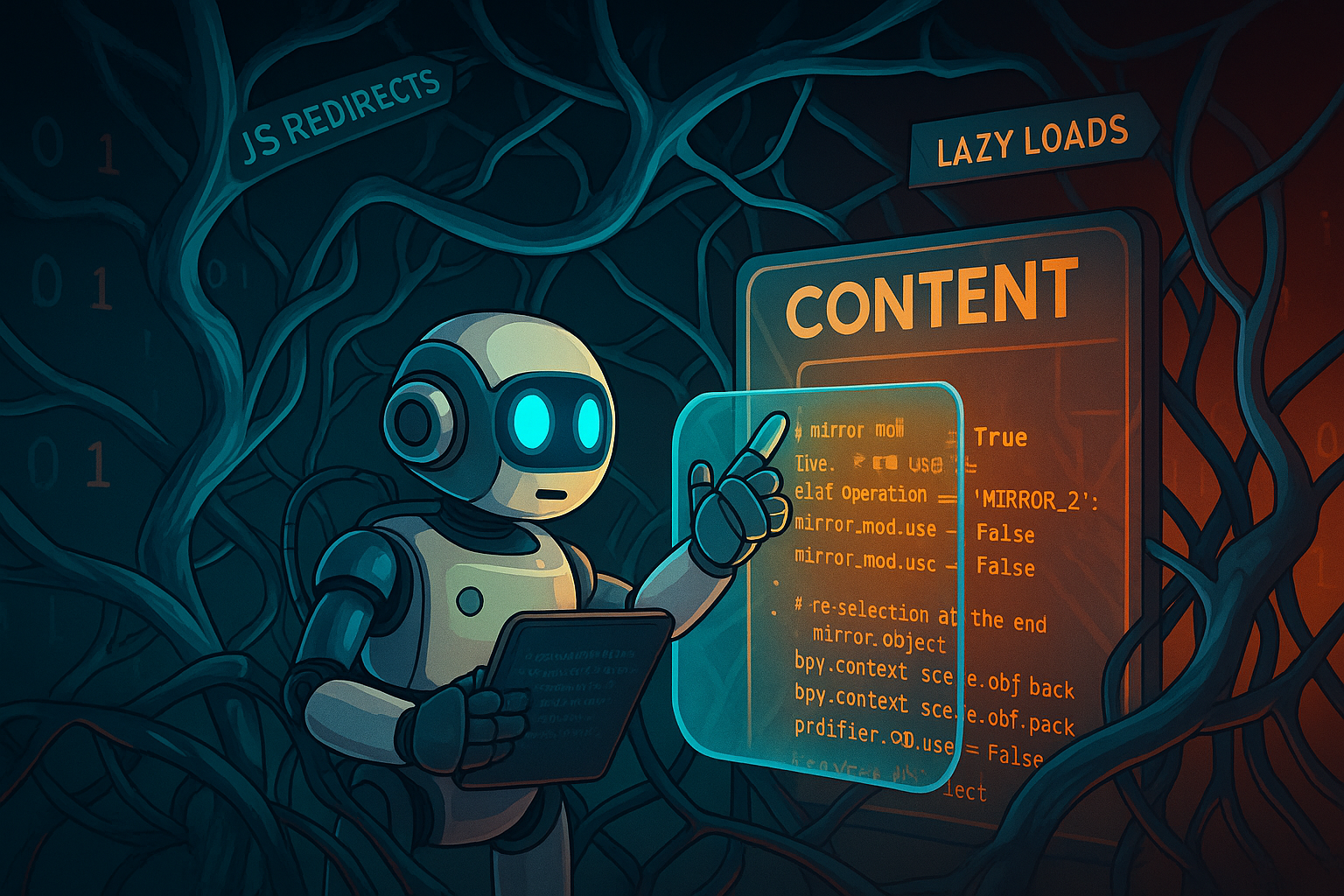AI agents are increasingly being used to gather and evaluate online content, particularly for search-driven tasks. Once an agent identifies a website it wishes to access, it must retrieve content in a usable form. However, many websites implement digital barriers - often invisible to everyday users - that can limit or entirely block AI systems from proceeding. These blocks are typically part of a site's infrastructure and serve a range of purposes, from reducing server strain to protecting proprietary information.
This article outlines the most common types of digital blocks that AI agents encounter, focusing solely on factual and technical aspects relevant to business and marketing leaders.
1. Bot Protection Systems
Many websites are protected by bot management platforms such as Cloudflare, Imperva, Akamai, or AWS WAF. These platforms analyze incoming traffic and determine whether it originates from a human or an automated system.
One common technique is the use of JavaScript challenges. These are brief scripts that verify user behavior by evaluating whether the browser can correctly execute JavaScript and return specific values. If the visitor fails to complete the test, access is denied or redirected.
Some systems implement CAPTCHA challenges, which request a visual or interactive response that automated systems typically cannot solve without external help.
2. Request Header Filtering
Web servers examine HTTP headers to determine whether a request seems legitimate. These include the User-Agent, which identifies the software making the request. If this string suggests that the request originates from a tool like curl, wget, or a headless browser, access may be denied.
In addition to the User-Agent, other headers like Accept-Language, Referer, or X-Requested-With are checked for patterns consistent with real browsers. Missing or inconsistent headers can result in the site blocking the request.
3. Robots.txt Enforcement
The robots.txt file is a standard used to provide guidance to automated agents on what parts of a site they should or should not access. While originally intended as an advisory document, some sites use firewalls or server configurations to enforce robots.txt directives. If an agent accesses a disallowed path, the server may respond with a block or serve misleading content.
Although this is not technically a barrier in itself, the enforcement of these rules through infrastructure can function as one.
4. Hidden Traps and Honeypots
Websites sometimes insert elements that are invisible to users but detectable by automated systems. These include hidden links, form fields, or non-interactive elements that only bots would follow or complete. Triggering these elements can signal a non-human visitor, resulting in temporary or permanent blocks.
This technique is often used to distinguish between casual browsing and automated scanning behavior.
5. IP-Based Filtering
Web infrastructure frequently uses IP address analysis to limit who can access content. Requests originating from cloud providers like AWS, Google Cloud, or Azure may be flagged as non-human, and access may be restricted.
In some cases, websites implement geofencing. This restricts access to specific countries or regions based on the visitor’s IP address. AI agents operating from a blocked geography will be denied access, even if the content is otherwise publicly available.
6. Rate Limiting and Traffic Shaping
Web servers are configured to handle typical human browsing speeds. Automated agents, which can send multiple requests per second, may trigger rate-limiting protocols. These protocols respond with an HTTP status code 429 (Too Many Requests) or temporarily ban the requesting IP.
Some systems dynamically adjust limits based on behavior. For example, bursts of traffic followed by inactivity may be interpreted as suspicious. In such cases, the site may respond slowly or present progressively difficult challenges.
7. JavaScript-Rendered Content
Some websites rely on client-side JavaScript to load key content. This means that the content does not appear in the initial HTML response but is rendered dynamically in the browser.
AI agents that do not execute JavaScript will receive only the shell of the page, with little or no usable information. Accessing such content requires the ability to simulate full browser behavior, which can in turn trigger other bot detection mechanisms.
8. Session Management and Authentication
Certain sites require that visitors establish a session before accessing content. This typically involves the use of cookies, tokens, or login credentials. Sessions may expire quickly or include anti-replay features such as time-stamped tokens.
For AI agents, this creates two difficulties:
- Establishing a valid session
- Maintaining that session across multiple requests
Sites may also check whether session tokens are linked to other authentication methods like CAPTCHA, making automation more difficult.
9. TLS and Protocol Fingerprinting
Some advanced detection systems analyze how a visitor establishes a secure connection. This includes TLS handshake characteristics, such as the order of cipher suites or supported extensions. Variations in this handshake can identify traffic as originating from non-standard software.
This is referred to as JA3 fingerprinting, and it allows websites to detect even well-disguised automated tools by examining their low-level network behavior.
10. API Restrictions
Many sites expose their data via public or semi-public APIs, but access is often regulated through:
- API keys
- Quotas
- Referrer checking
Some APIs also inspect whether the request originated from a browser-based frontend. If an AI agent makes the call directly, it may receive a different response or none at all. Rate limits may be stricter than for web traffic, with rapid or high-volume queries quickly triggering access restrictions.
Digital barriers are not new, but their relevance has increased with the rise of AI agents that engage in web-based tasks. These agents often encounter layers of infrastructure designed to ensure that only human users—or authorized systems—can access meaningful content.
For organizations considering how their digital presence is evaluated or used by AI, it's worth noting that accessibility does not only depend on page design or search ranking. The technical infrastructure of a site may determine whether its content is even visible to automated systems. As the agentic web evolves, the ability of sites to either permit or deny access at a technical level will continue to shape how they are perceived, used, and integrated into AI-driven processes.

